Bike gears: shifting explained for beginners
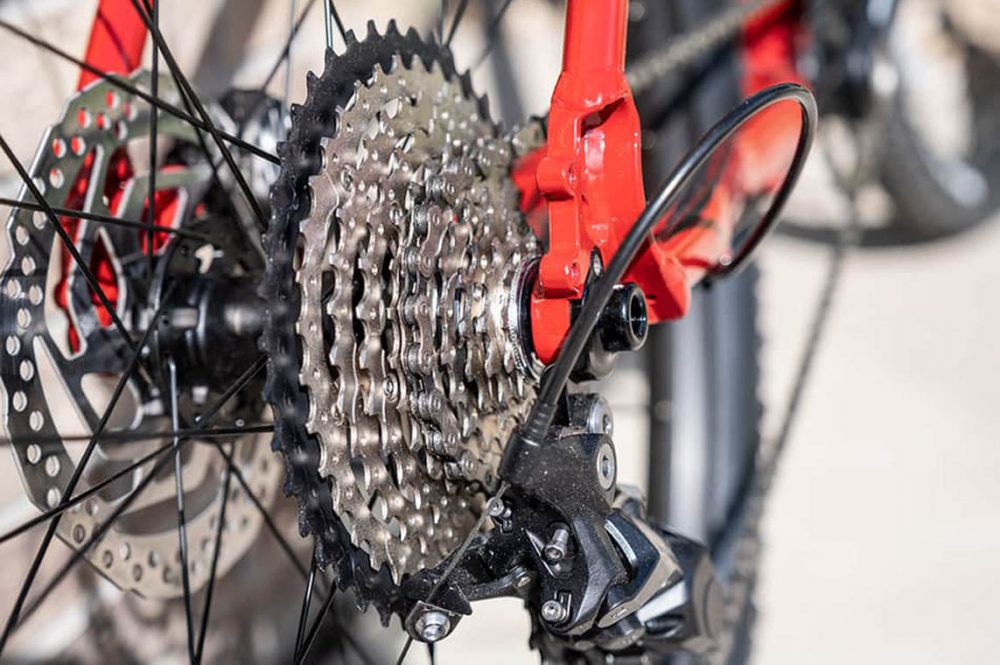 If you haven’t a clue how many gears your bike has, how many you actually need or even how to use them properly, don’t worry — you’re not alone. We uncover the mystery of the derailleur and sprockets and explain why in cycling STIs are a good thing to have.
If you haven’t a clue how many gears your bike has, how many you actually need or even how to use them properly, don’t worry — you’re not alone. We uncover the mystery of the derailleur and sprockets and explain why in cycling STIs are a good thing to have.
Understanding the basic principles of how bike gears work, and how changing the size of the front sprocket and rear cassette flywheel affects your pedaling will help you choose the gear that best suits your abilities.
It is difficult to know whether you need a classic, compact, or medium-compact chain group, and then you may need a 10-speed, 11-speed or even now a 12-speed groupset to use it. In the following article, we will help you become a more efficient gear-savvy cyclist-we guarantee.
Bike gears: the basics
What determines the number of bicycle gears you have?
This is the simple product of the number of rear sprockets and the number of front sprockets. Therefore, a three-sprocket setup with a 10-speed rear sprocket is a 30-speed bicycle—in other words, all 10 sprockets can be combined with each of the three sprockets. Similarly, a dual-sprocket paired with an 11-speed sprocket is a 22-speed setting, and so on.
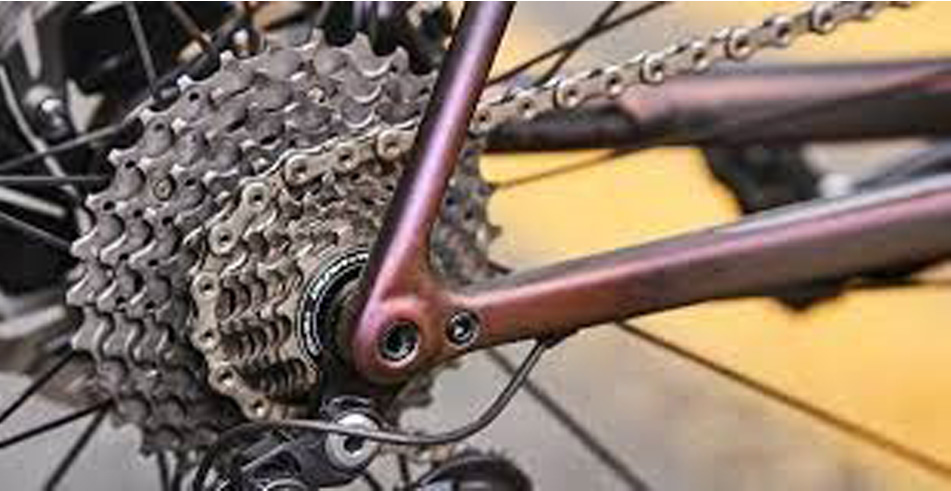
Why do you road bikes need gears?
Why should there be gears? Well, in short, gears can keep us pedaling at a comfortable speed (or rhythm) regardless of the slope or terrain-this is something that no gear can do.
The high gear, sometimes referred to as the “high gear” by cyclists, is the best choice when riding downhill or at high speeds. The tallest or largest gear on a bicycle is achieved by combining the largest front sprocket size with the smallest rear gear or sprocket—for example, expressed as “53×11”.
And vice versa, combining the smallest front sprocket size with the largest rear sprocket size will produce the lowest usable gear, which will help you keep the pedals spinning when the road is steep.
Let us be clear about one thing-having a lot of gears is not to make the bike faster. A bike with 30 or more gears does not mean that the machine is designed to break land speed records, rather than a bicycle with only one gear, assuming similar ratios.
It is about efficiency and has a wider range or choice of gears under certain circumstances. Just like a car, a bicycle can accelerate from a standstill or climb steep hills through a low gear, while on the other hand, a high gear can help you achieve high speeds without over-accelerating.
Continuing to take a bike as an example, using a gear that is too low at high speed will result in high fuel consumption. The same goes for your body riding a bike. Therefore, it is simple, more gears means more room to find the pedaling speed you like.
From this point of view, in the age of five-speed or six-speed flywheels, the range of 12-25 teeth can only be achieved by a considerable gap between the sprocket sizes. Modern 10-speed or even 11-speed flywheels have the same 12-25 pitch, with only single-tooth increments in most transmissions.
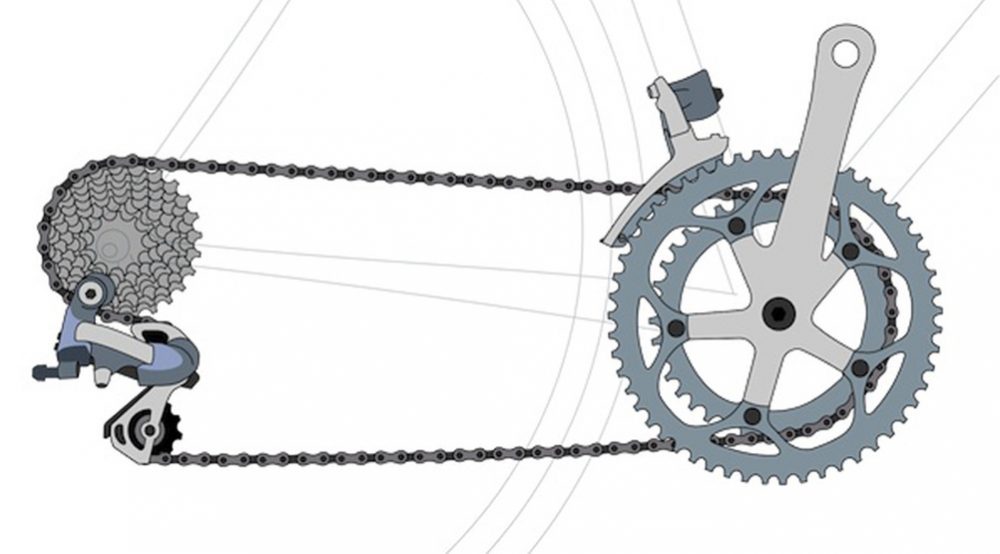
Why do some people choose single-speed bikes?
You don’t have to ride a bike with gears-some people choose to ride a single-speed bicycle. These still have a gear-determined by the size of the front sprocket and rear gear.
Single-speed bicycles are popular among commuters living in flat areas because they require little maintenance. They are also used by some racing drivers who want to reduce weight and reduce any additional complexity during gear changes-in this case, choosing the right gear ratio is crucial. In the end, track bikes have only one gear-although riders will again change their settings to suit certain events.
The result is a smoother and more precise gear shift, because the chain must overcome the mechanical difficulties to climb a larger sprockets or descend to a smaller sprockets, with smaller increments, but most importantly, it is possible Greatly improve pedaling efficiency. Cyclists are better able to fine-tune their pedaling speed to suit the slope or terrain, usually reducing energy costs.
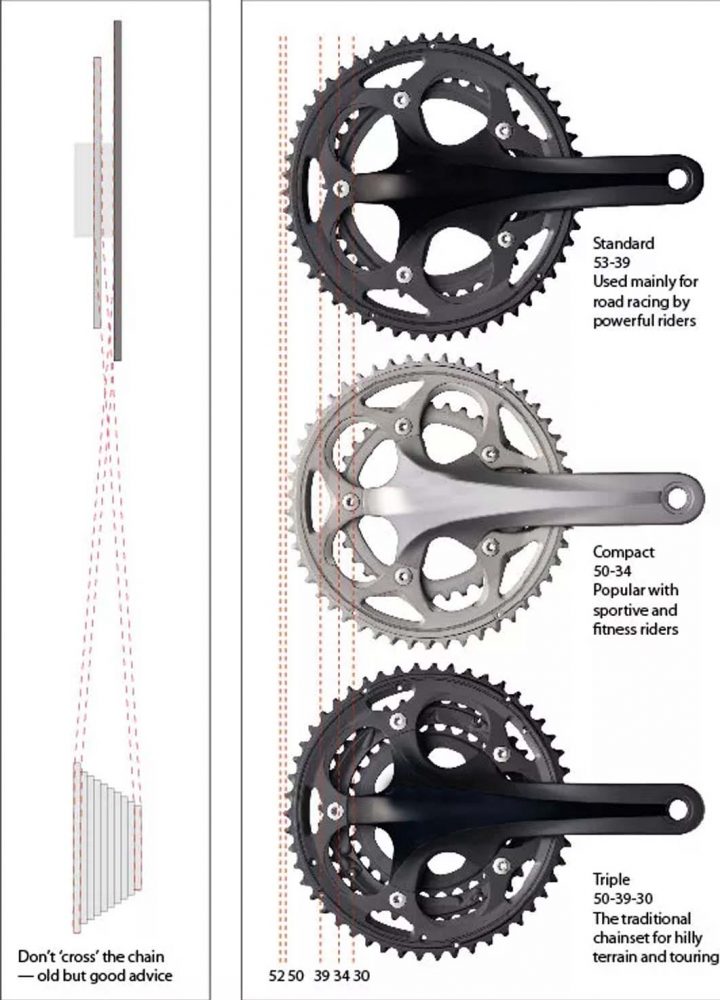
Win some, lose some
The reality is that in a multi-gear setting, especially when up to 33 gears are provided, “overlapping” gears is inevitable. In other words, certain gear combinations will result in the same ratio as other gear combinations that use different sprockets and sprockets. For example, 53×19 and 39×14 are the same gear.
In addition, due to the additional strain exerted on the chain, certain “cross” gears at the extremes of this range may not be recommended. The old advice that still applies is to avoid “cross-chain”. Please refer to the figure below to illustrate this point.
So you don’t always get 33 gears, but this is not some kind of marketing trick of the manufacturer, to deceive you cunningly, this is just the nature of the beast.
As we have already said, the total is not a selling point, but the ability to make continuous progress for closely spaced gears.
There is no need to struggle these days, because there are so many shifting options to choose from, so riders of all abilities can get the most out of their pedals. The trick is to know what is what, so you can decide what is best for your ride. This is the inside information that puts you on the right track.
Guide to different types of gears
standard two-person room
There are two sprockets at the front and up to 11 sprockets at the rear. Common gear ratios are 39t or 42t for the inner ring and 52t or 53t for the outer ring. The standard dual setting is usually the first choice for racing cars. It provides the largest sprocket size for the largest gear, allowing you to pedal smoothly at high speeds.
The lower gear transmission may be reduced, but it can only be as low as 38 tons of inner sprocket teeth, so if you want a low-end gear, a standard double-sprocket is not the best choice. The 52t chainring can be used with the 36t internal chainring to form a “semi-compact” chainring set.
Triple
Having three sprockets can add a smaller gear option. The third chainring is usually 30t or less. When used in conjunction with a rear flywheel with a large transmission ratio, it can provide extremely low gears for steep climbs. Tricycles are the first choice for riders seeking the “rescue” option, usually those who often ride in very hilly areas.
While baggage makes the battle against gravity more difficult, it is also good for full-load travel.
Compact
The compact is basically a dual setup, just
smaller. Both chainrings have been reduced in size, usually 34 tons or 36 tons
inside, with 48 tons or 50 tons outside, thereby reducing the gear ratio of the
entire range. It is currently a very popular choice because the reduction in
low gears is enough for most people to cope with climbing in the Alps, but the
top gears are not significantly reduced, and rapid descent is still allowed.
Hub gear
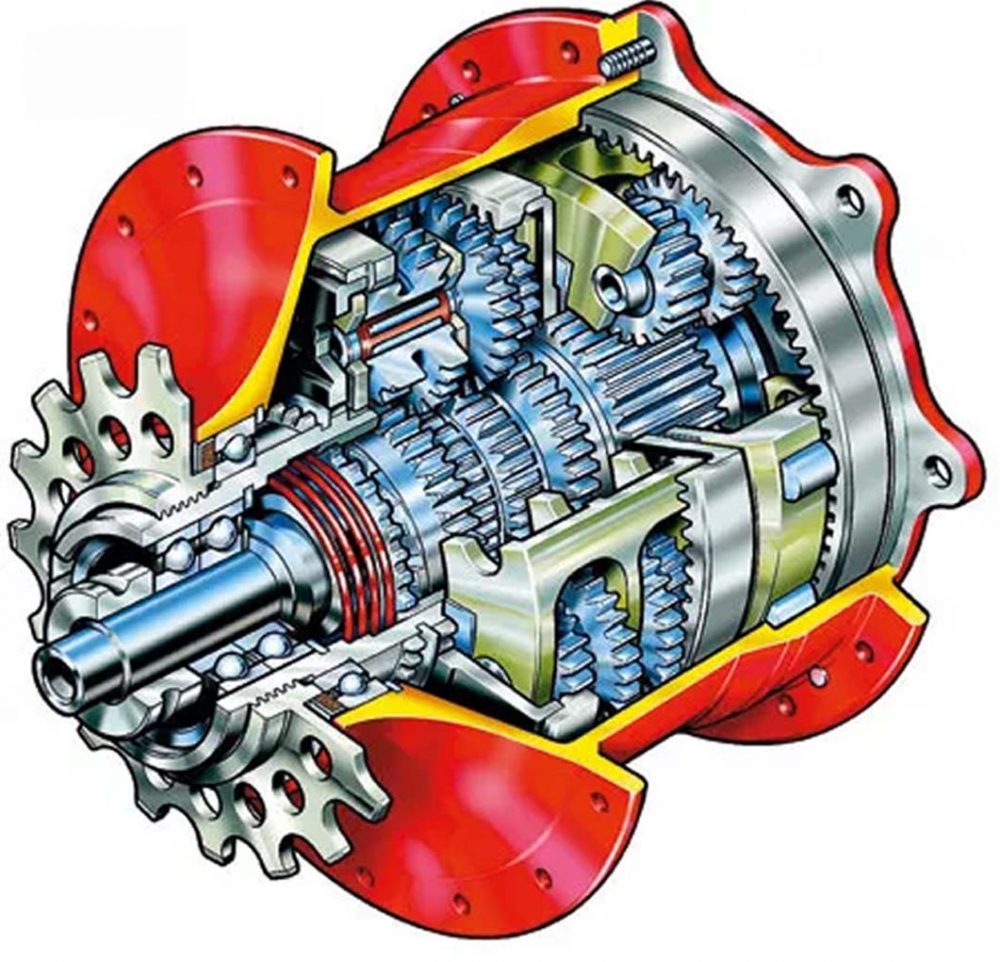 This sturdy, low-maintenance planetary gear system is installed in a thick rear hub and is still powerful. The popular Rohloff hub has 14 gears, while companies such as SRAM, Shimano and Sturmey-Archer offer 4, 7, 8, 9 and 12 speed options.
This sturdy, low-maintenance planetary gear system is installed in a thick rear hub and is still powerful. The popular Rohloff hub has 14 gears, while companies such as SRAM, Shimano and Sturmey-Archer offer 4, 7, 8, 9 and 12 speed options.
There may be fewer individual gear options than using a derailleur system, but it is still possible to personalize the transmission ratio by adjusting the size of the chainring and rear sprocket. Hub gears are usually very sturdy and require little maintenance, so they are great for everyday commuter bikes, especially because most hub gears allow you to change gears without pedaling-handy at traffic lights. Their weight is their Achilles’ heel, which is not good for them in hilly terrain and long-distance riding.
PMP 33t chainring
As a simple fix to further reduce the compact gear ratio. The 33t ring of PMP simply replaces the standard 34t, and Bob is your uncle… the bottom level is lower.
Carton ratio
What does 11-23 or 12-25 refer to? The first number is the smallest sprocket size, usually 11t or 12t, and the second number is the largest sprocket size, usually from 21t to 28t, sometimes larger.
How does a road bike gear lever work?
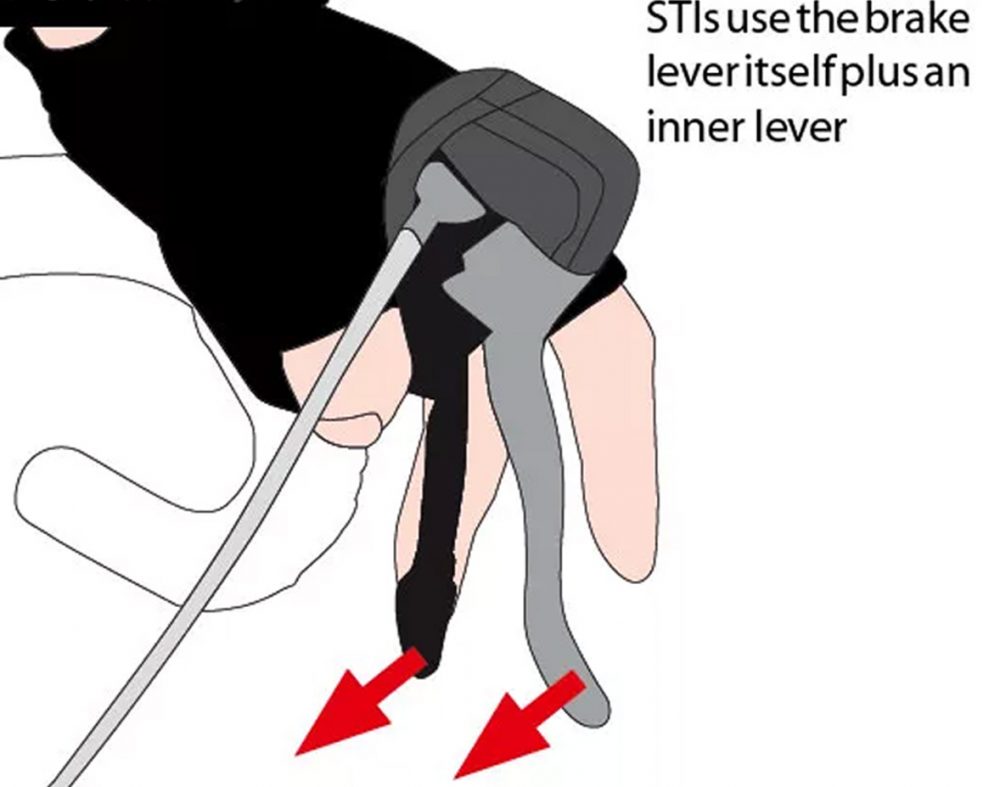 For some modern designs, the position of the shift lever is not always obvious. If you have any questions, your local bike shop will answer it for you, but here are the basics of most products on the market. Regardless of the brand, the right hand controls the rear derailleur and the left hand controls the front derailleur.
For some modern designs, the position of the shift lever is not always obvious. If you have any questions, your local bike shop will answer it for you, but here are the basics of most products on the market. Regardless of the brand, the right hand controls the rear derailleur and the left hand controls the front derailleur.
The language of bike gears
Chain ring: The gear ring at the front end of the transmission system, attached to the crank.
Cassette: A set of sprockets at the rear of the transmission system, containing up to 11 gears of different sizes.
Block: Another term for the rear sprocket, but actually refers to the older screw-in flywheel.
Derailleur: The front and rear derailleur completes all the heavy work of moving the chain from one sprocket (or sprocket) to the next.
Sprocket: Refers to a single gear in the cassette/block.
Ratio: Describe the relationship between the sprocket and the sprocket, such as “53×12” or the sprocket on the flywheel (11-25).
t: The abbreviation of tooth-describes how many sprocket wheels are given-for example “23t”.
Transmission system: The term combines all the moving parts that connect the crank and the rear wheel to drive the bicycle-namely the chain, the flywheel and the chainring.
Cadence: The pedaling speed, which is measured by the number of revolutions of the crank per minute-expressed in RPM.
STI Lever: The abbreviation of “Shimano Total Integration”-Shimano is a design term that combines road bike brakes and gear levers, but is often (wrongly) used to refer to gear/brake levers in general, regardless of the brand.
Ergo lever: The name of Campagnolo, derived from its integrated shift and brake lever version (ie Campagnolo’s STI).
Double Tap Leverage: A piece of SRAM’s cake, as far as shifting technology is concerned-the same lever is used for upshifts and downshifts.
If you are interested in our electric bikes, you can leave a message. If you have any query please feel free to contact us. We are looking forward to your arrival.
 Shuangye ebike
Shuangye ebike
